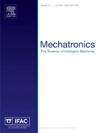Natural efficient gaits from Nonholonomic Locomotion Nonlinear Normal Mode (NL-NNM): The Pendrivencar case
IF 3.1
3区 计算机科学
Q2 AUTOMATION & CONTROL SYSTEMS
引用次数: 0
Abstract
Bio-inspired robots remain far less energy-efficient than animals because conventional controllers impose trajectories that fight passive dynamics, whereas animals exploit resonance through natural nonlinear normal modes (NNM), whose periodic internal motions form a smooth 2D invariant surface; We ask how to define and compute the natural motions of a conservative locomotion system: propulsion arises only from no-slip constraints, and once initiated, a gait persists without actuation—like a frictionless pendulum. We tackle non-holonomic constraints on the Pendrivencar, a vehicle driven by a motorised pendulum with a cubic torsional spring; We introduce the Nonholonomic Locomotion - NNM (NL-NNM): extract a high-speed spectral seed – where chassis oscillations vanish and the pendulum is neutrally stable – refine the periodic orbit, and continue the resulting 2D invariant manifold via pseudo-arclength across three slow centre manifolds (stable for positive speed, neutral at zero, unstable for negative) from non-isolated rectilinear equilibria; We demonstrate the first NL-NNM for a moving non-holonomic robot: internal orbits produce a pendulum–chassis choreography whose energy-dependent frequency shifts and harmonic richness exceed linear predictions. Via geometric phase, each orbit yields undulatory straight-line motion. A dual-loop control simulation confirms autonomous path tracking with only the pendulum; Extending to dissipative regimes via non-linear resonant modes offers a path to high-efficiency locomotion in aquatic, aerial, legged, soft-bodied, and other robots.
非完整运动非线性正态模式(NL-NNM)的自然有效步态:Pendrivencar情况
仿生机器人仍然远不如动物节能,因为传统的控制器施加的轨迹与被动动力学作斗争,而动物通过自然非线性正常模式(NNM)利用共振,其周期性内部运动形成光滑的二维不变表面;我们的问题是如何定义和计算一个保守运动系统的自然运动:推进只产生于无滑移约束,一旦启动,步态就会在没有驱动的情况下持续存在,就像一个无摩擦的钟摆。我们解决了Pendrivencar的非完整约束,Pendrivencar是一种由带有三次扭转弹簧的机动摆驱动的车辆;我们引入了非完整运动-NNM (NL-NNM):提取高速光谱种子-底盘振荡消失,钟摆中立稳定-细化周期轨道,并通过非孤立直线平衡中的三个慢中心流形(正速度稳定,零中立,负不稳定)的伪弧长继续得到二维不变流形;我们展示了第一个用于移动非完整机器人的NL-NNM:内部轨道产生钟摆-底盘编排,其能量依赖的频移和谐波丰富度超过线性预测。通过几何相位,每个轨道产生波动的直线运动。双环控制仿真证实了单摆的自主路径跟踪;通过非线性共振模式扩展到耗散状态,为水生、空中、腿式、软体和其他机器人的高效运动提供了途径。
本文章由计算机程序翻译,如有差异,请以英文原文为准。
求助全文
约1分钟内获得全文
求助全文
来源期刊

Mechatronics
工程技术-工程:电子与电气
CiteScore
5.90
自引率
9.10%
发文量
0
审稿时长
109 days
期刊介绍:
Mechatronics is the synergistic combination of precision mechanical engineering, electronic control and systems thinking in the design of products and manufacturing processes. It relates to the design of systems, devices and products aimed at achieving an optimal balance between basic mechanical structure and its overall control. The purpose of this journal is to provide rapid publication of topical papers featuring practical developments in mechatronics. It will cover a wide range of application areas including consumer product design, instrumentation, manufacturing methods, computer integration and process and device control, and will attract a readership from across the industrial and academic research spectrum. Particular importance will be attached to aspects of innovation in mechatronics design philosophy which illustrate the benefits obtainable by an a priori integration of functionality with embedded microprocessor control. A major item will be the design of machines, devices and systems possessing a degree of computer based intelligence. The journal seeks to publish research progress in this field with an emphasis on the applied rather than the theoretical. It will also serve the dual role of bringing greater recognition to this important area of engineering.
 求助内容:
求助内容: 应助结果提醒方式:
应助结果提醒方式:


